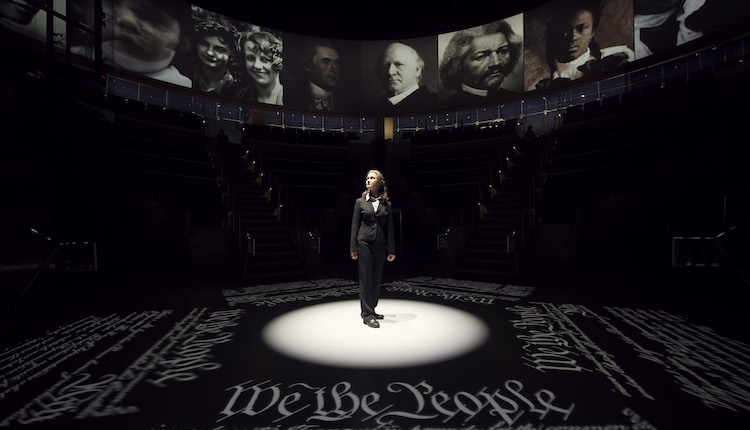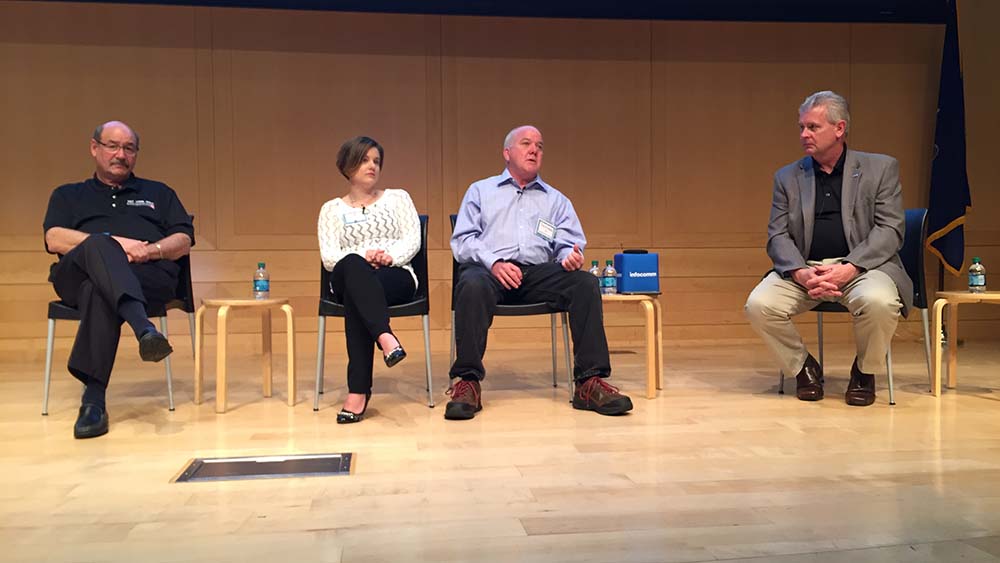CED, Panasonic Refresh AV for National Constitution Center Production

The U.S. Constitution has been called many things over the years, but “exciting” isn’t typically one of them. So, in developing a technological upgrade for the National Constitution Center’s (NCC) “Freedom Rising,” a theatrical presentation on the history of America’s governmental framework, stunning video and audio were a must.

“Freedom Rising” is a 15-minute production with a live actor accompanied by AV, including a 360-degree seamless projection screen that encircles the theater. Actor: Susie Stevens, Photo Courtesy: National Constitution Center
In 2016, integrator CED refreshed the aging technology from the Philadelphia museum’s theater with a truly immersive audiovisual experience featuring a 360-degree seamless video projection screen and 35 LED smart lights.
On May 2, InfoComm International hosted an event at the NCC, along with CED and Panasonic—whose projectors were used in the upgraded production—to discuss the process of revamping the experience and to see the finished product firsthand.
“This was a $3 million upgrade; it wasn’t just the technology,” said Steve Shiekman, senior operations manager at the NCC. “We did the seats, we did the lighting, we did the carpeting, we refinished the floor. It was a total upgrade from top to bottom, and it’s just made what we like to call the ‘visitor experience’ greatly enhanced over what it was. This is the first thing that visitors see when they come into the center; this is the orientation.”
The first thing AV-savvy visitors might notice when they come into the theater is the 12-foot-high, 250-foot-circumference screen that circles above the 85-foot-wide theater. This is the canvas for the seamless 360-degree video presentation that accompanies the narration of the show’s actor as he or she tells the story of the U.S. Constitution.
According to Shiekman, the old configuration, which operated from the theater’s opening in 2003 until last year, consisted of 16 separate screens with borders between them, and projectors with bulbs that needed changing three and a half times per year—a tremendous expense given the amount of use the system gets.
A daily selection of the top stories for AV integrators, resellers and consultants. Sign up below.

The panel discusses the installation on May 2. (L to R): Steve Shiekman, NCC; Mandie Clark, CED; Tim Creed, CED; and Paul DeLorenzo, Panasonic.
“We average close to 70 hours a week on a normal schedule, and we also have evening rentals that adds to it,” Shiekman said. “So we’re at anywhere between 3,300 to 3,600 hours per year. “When we were using OEM lamps on the previous system, it was $11,000 to re-lamp the theater. Put that into a budget three and a half times per year…” The new setup, in contrast, only requires bulbs to be changed every 10 to 11 months, or when the projector performance is reduced to 90 percent rate of life.
Overall, the new configuration utilizes 16 Panasonic projectors: 10 located 36 feet above the stage in a catwalk gantry for the surround screen, one directly above the floor for stage projection, and five around the lower level that project onto a five-sided scrim that drops down toward the end of the show. Edge blending between the projectors on the surround screen is performed with Scalable Display Technologies software, a 7thSense media server drives the show, and the entire system is controlled by AMX.
With so many projectors in use, one might expect that a lot of calibration would be required to keep everything aligned. According to Tim Creed, senior design engineer and owner of CED, that hasn’t been the case. “The gantry that holds the projectors is really well built, very stable,” he said. “We had it set up as a one-button calibration; we assumed it would probably need to be done weekly, possibly daily. As it turned out, it held through to the first lamp change. So we’re very happy with the way it worked, and really happy with the stability of the mount.”
In fact, the greatest challenge of the installation, according to Mandie Clark, lead project engineer at CED, was on the audio side—namely, latency from the live actor’s mic, which took a number of adjustments to resolve, and setup issues owing to the variety of performers.
The production utilizes a revolving cast of actors, so CED developed a system where each actor has his or her own profile for the head-worn Point Source microphone. “What we developed was an audio server with Richmond Sound Design and AMX interface, and were able to set up EQ with each microphone and actor,” Clark said. “As each actor comes in, they can select which microphone channel they’re using, and which EQ preset they need. So the system we developed is very flexible, and very powerful, and we really used it to the maximum in this instance.”
This audio system fits well with CED’s goal of providing the NCC with a show that’s very straightforward to run, according to Creed. “Our goal is unattended operation, and that’s what we’re shooting for,” he said. “Other than starting the show and selecting presets, it pretty much is.”
The end result is a production that educates, entertains, and inspires visitors 15 times per day—and an AV backbone that helps bring to life the story of one of America’s greatest contributions to the history of civilization.
“I’ve seen it several dozen times, and every time I see it, I get goosebumps at the end,” Shiekman said. “It’s just one of those very stirring productions.”
Matt Pruznick is the former editor of AV Technology, and senior editor for Systems Contractor News and Residential Systems. He is based in New York.

